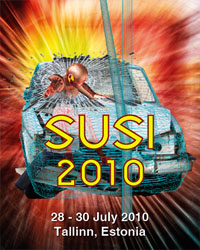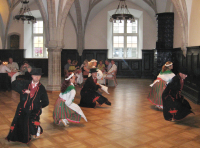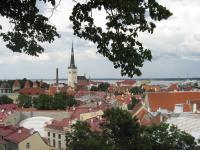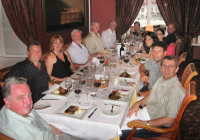11th International Conference on Structures Under Shock and Impact
28 - 30 July 2010
Tallinn, Estonia
Overview
 The eleventh International Conference on Structures Under Shock and Impact (SUSI XI) has recently been held in Tallinn, Estonia.
The eleventh International Conference on Structures Under Shock and Impact (SUSI XI) has recently been held in Tallinn, Estonia.The Conference Chairmen were Professor Norman Jones of the University of Liverpool, UK; Professor Carlos A Brebbia of the Wessex Institute of Technology, UK and Professor Ulo Mander of Tartu University in Estonia.
The first conference in this series was held in Cambridge, Massachusetts in 1989; followed by Portsmouth, UK in 1992; Madrid in 1994; Udine in 1996; Thessaloniki in 1998; Cambridge, UK in 2000; Montreal in 2002; Crete in 2004 and the Wessex Institute of Technology campus in 2008. The objective of these meetings is to bring together engineers and scientists from a wide range of academic disciplines and industrial backgrounds who are interested in the shock and impact analysis of structures and materials. The conferences bring to the attention of the entire community the major advances in different areas.
Opening Addresses
Professor Carlos Brebbia opened the meeting by explaining the work of the Wessex Institute of Technology, which acts as a mechanism for the transfer of knowledge across different disciplines. Professor Brebbia said that the WIT conferences aim to achieve the maximum degree of interaction between the participants. WIT sees the conferences as the start – rather than the end – of a process of information dissemination. The proceedings of this conference, for instance, are published in paper and digital format and archived in the Wessex Institute eLibrary http://library.witpress.com. They are widely distributed and furthermore, authors are invited to submit extended versions of their presentations for publication in one of the Journals administrated by WIT.Professor Brebbia explained that many of the books published by WIT are a direct result of contacts at conferences. This also applies to international projects put together by the participants (WIT is currently a partner in four major EU projects amongst others).
Professor Brebbia ended by thanking the participants for having come to Tallinn and hoping that they will enjoy the city as well as the conference. Tallinn is a very beautiful town and the people are very proud of their independence and take good care of the environment, all of which contributes to the success of SUSI.
Professor Norman Jones welcomed the participants and discussed the important of structural shock and impact.
Professor Jones referred to some of the engineering problems in the field of engineering sciences that impact on the topics discussed at the meeting. One of them is the exaggerated expectations of what robust FEM models can do. They are, in many cases, characterisation of real problems, without encompassing the complete set of equations that can represent the problem. It is essential - Norman said – to validate the models. In spite of this, FEM is an essential tool of modern design that allows us to expand the range of applications and new structural challenges.
The shock and impact of structures is a challenging area, not only because of the obvious time-dependant aspects, but also because of the difficulties in specifying the external dynamic loading and correct characteristics for structural design and hazard assessments, and in attaining the dynamic properties of materials. Thus it is important to be aware of the advances made by theoretical, numerical and experimental studies of structures, as well as investigations into the material properties under dynamic loading conditions.
Conference Sessions
The papers presented at the conference reflect the broad range of practical interest in the shock and impact response of structures. The topics include various aspects of protection, such as protection of buildings from explosive loads and the protection of the public through structural energy absorbing systems. Some presentations examined the response of concrete, composite and metal structures under a variety of impact and blast loadings. Individual papers focused on seismic loadings, missile penetration, energy absorbing systems, structural crashworthiness and other important industrial problems, some of which are studied using numerical schemes. Several papers examined the dynamic properties of materials. The papers were classified in the following sessions;
The papers were classified in the following sessions;- Protection of structures from blast loads
- Structural crashworthiness
- Energy absorbing issues
- Impact and blast loading
- Hazard mitigation and assessment
- Seismic behaviour
- Behaviour of structures
Invited Presentations
There was also a series of invited presentations by well-known colleagues;‘Theory and calibration of JWL and JWLB thermodynamic equations of state’
by E L Baker, US Army ARDEC, USA
‘Modelling the response of UHPFRC panels to explosive loading’
by G K Schleyer, University of Liverpool, UK
‘Structural retrofit of glazing systems with polymer materials for blast resistance’
by K Marchand, Protection Engineering Consultants, USA
‘Numerical determination of reflected blast pressure distribution on round columns’
by P J Heffernan, Royal Military College of Canada
‘Simplified evaluation of a building impacted by a terrorist explosion’
by D Makovicka, Czech Technical University, Prague
‘Impact loading of ductile rectangular plates’
by N Jones, University of Liverpool, UK
Conference Dinner and Excursion
 The conference banquet took place in the renown Black Head Guild House, belonging to an ancient trading brotherhood that has similar sites all over the Hanseatic ports. The building was used to house the brotherhood traders and store their merchandise. The room for the banquet took place has an ornate roof with nervatures as found in some gothic churches. There the conference dinner took place, followed dances by an Estonian folkloric troupe. After that the local organiser, Professor Ulo Mander, convinced most delegates to render a national song with various degrees of success. The evening was most enjoyable and helped to cement the strong links already developing amongst the participants.
The conference banquet took place in the renown Black Head Guild House, belonging to an ancient trading brotherhood that has similar sites all over the Hanseatic ports. The building was used to house the brotherhood traders and store their merchandise. The room for the banquet took place has an ornate roof with nervatures as found in some gothic churches. There the conference dinner took place, followed dances by an Estonian folkloric troupe. After that the local organiser, Professor Ulo Mander, convinced most delegates to render a national song with various degrees of success. The evening was most enjoyable and helped to cement the strong links already developing amongst the participants.At the end of the second afternoon session, the delegates participated in a guided tour through the historical centre of
 Tallinn. At the heart of Tallinn is the Old Town, which was once enclosed by the city’s medieval walls. The Town Hall, dating from the XIVth century, has been the centre of Tallinn’s life since then as it is now the focus of festivals and many other events. The square is surrounded by beautiful buildings once belonging to the richest merchants in town. In one of its corners stands the oldest pharmacy in Europe, still serving the public. A bit further from the square is the Museum of Tallinn, charting the history of the region since prehistoric times. The whole of the old town is now alive with excellent restaurants, animated bars and public attractions, which makes this one of the most pleasant tourist destinations in Europe.
Tallinn. At the heart of Tallinn is the Old Town, which was once enclosed by the city’s medieval walls. The Town Hall, dating from the XIVth century, has been the centre of Tallinn’s life since then as it is now the focus of festivals and many other events. The square is surrounded by beautiful buildings once belonging to the richest merchants in town. In one of its corners stands the oldest pharmacy in Europe, still serving the public. A bit further from the square is the Museum of Tallinn, charting the history of the region since prehistoric times. The whole of the old town is now alive with excellent restaurants, animated bars and public attractions, which makes this one of the most pleasant tourist destinations in Europe.International Scientific Advisory Committee

The International Scientific Advisory Committee met towards the end of the conference to discuss how the meeting could be improved and reconvened in 2012. Different suggestions were put forward including the need to organise a special session on emerging topics. Several possible locations were discussed and WIT will investigate them to find a suitable venue which can help to increase the interaction amongst delegates. The WIT conference department will now investigate these locations.
Reconvening of the Conference
It is clear from the presentations at the conference that shock and impact behaviour of structures is an active field and that the range of topics is ever expanding when viewed from the perspective of the eleven conferences in this series. The situation bodes well for the future growth of the subject, particularly since 9/11, which brought increased concern for protecting public buildings, nuclear and other plants and other important sites. In addition, there is a continuing interest in the effects of shock and impact loadings and the quest for optimised systems ad the resistance of new materials. Because of this, the conference will be reconvened in 2012 in a place and at a time to be decided shortly.Publication of Papers
The proceedings of Structures Under Shock and Impact XI, 368pp (Print ISBN: 978-1-84564-466-6; Online ISSN: 1743-3509) are available from WIT Press priced at £140/US$280/€198. Orders can be placed online at www.witpress.com or by email: This email address is being protected from spambots. You need JavaScript enabled to view it., telephone: +44 (0) 238 029 3223 or fax: +44 (0) 238 029 2853.Papers from the conference will also be hosted online in the WIT eLibrary as Volume 113 of WIT Transactions on the Built Environment (ISSN: 1743-3541). For more details visit the WIT eLibrary at http://library.witpress.com


 Wessex Institute
Wessex Institute